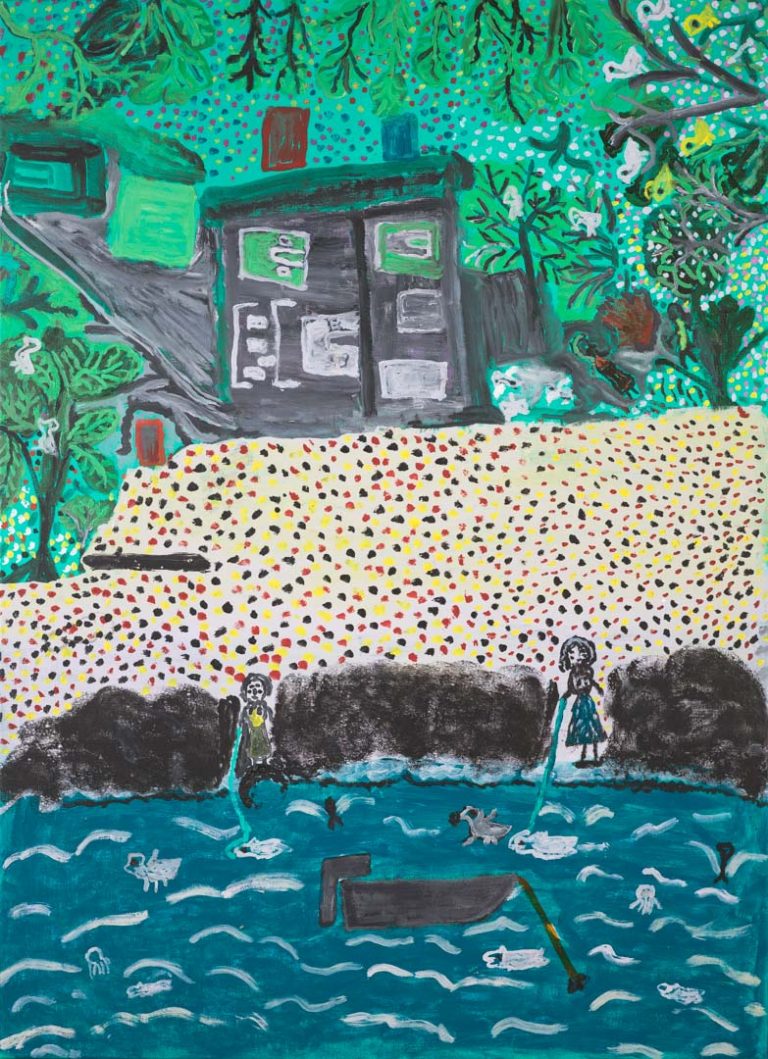We acknowledge the Traditional Owners of the land on which the Queensland Art Gallery | Gallery of Modern Art stands and recognise the creative contribution First Australians make to the art and culture of this country.

Mavis Ngallametta / Kugu-Uwanh people, Putch clan / Australia 1944–2019 / Wutan 2011 / Synthetic polymer paint on linen / 129 x 94cm / Gift of the artist through the Queensland Art Gallery | Gallery of Modern Art Foundation 2015. Donated through the Australian Government’s Cultural Gifts Program / Collection: Queensland Art Gallery | Gallery of Modern Art / © The Estate of Mavis Ngallametta
Mavis NGALLAMETTAWutan 2011
On Display: GOMA, Gallery 3.5
We always go camping and fishing here at Wutan. My adopted son Edgar made this shed for us to go camping in. This is his country and he always brings us here camping and fishing. That is me and my sister Doris fishing. We caught plenty that day and there was plenty of birds fishing too. In the mission days and when we were children, we used to spend our school holidays here with the mission people.1
When Mavis Ngallametta painted, she often used a unique perspective. Neither the flat, feet-on-ground perspective traditionally used in landscape painting, nor the bird’s-eye view that is most often associated with Aboriginal painting, Ngallametta’s perspective is best described as a view at an angle of roughly 45-degrees. In Wutan 2011, an important early example of this perspective, the artist has divided the composition into thirds — the water of the inlet at Wutan sits at the bottom, the sandy bank appears in the middle, while the hills and trees sit at the top of the painting.
Endnotes:
1. Mavis Ngallametta, quoted in QAGOMA Research Library Collection Artist File, 2015.
Mavis Ngallametta was born in 1944 into the Marbunt family of the Kugu people on their traditional country, near the Kendall River in west Cape York Peninsula. An elder of the Putch clan and a cultural leader of the Wik and Kugu people of Aurukun, Mavis is remembered for her rich legacy to her community and to art and culture nationally. Mavis embarked on her journey to become a painter relatively late in life — she did not pick up a paintbrush until 2008, at the age of 64.
Mavis lived a traditional life in the bush until she was around five, when her family was moved to the Presbyterian Mission at Aurukun. She maintained connections with family members and elders despite this upheaval, and, in time, learnt to weave dilly bags and fruit bowls made from cabbage palm and pandanus. As a result, she was first recognised for her weaving using traditional materials, which later expanded to include recycled driftnets and marine debris.
In 2008, Ngallametta began making small paintings depicting important cultural sites, and from 2010, her works grew in scale. Mavis tended to depict sites of personal significance in her paintings. Recurring subjects include Ikalath, where she collected white clay; her traditional country of Kendall River; Wutan, a camping site belonging to her adopted son Edgar; and various pamp, or swamps, dotted around Aurukun.
Discussion Questions
1. Wutan 2011 and Wutan #2 2014 depict a site of personal significance for Mavis Ngallametta. How has the artist’s visual language changed between the two works?
2. What do you think is the focal point of Wutan 2011? What is it about this feature that draws the eye?
Classroom Activities
Choose a place that is important to you. Select a photograph of your place taken from the ground and another from a corresponding aerial view (either a map or a satellite image). Using both images for reference, draw or paint a view of this site as you imagine it from a 45-degree angle.